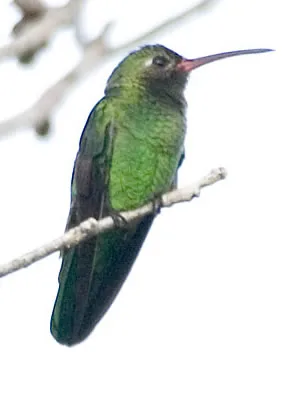
Green-tailed Goldenthroat
[order] Apodiformes | [family] Trochilidae | [latin] Polytmus theresiae | [UK] Green-tailed Goldenthroat | [FR] Colibri tout-vert | [DE] Grunschwanz-Glanzkehlchen | [ES] Colibri de Teresa | [IT] Colibri codadorata codaverde | [NL] Groenstaart Goudkeelkolibrie
Subspecies
| Genus | Species | subspecies | Breeding Range | Breeding Range 2 | Non Breeding Range |
| Leucippus | theresiae | ||||
| Polytmus | theresiae | SA | ne, w Amazonia | ||
| Polytmus | theresiae | leucorrhous | e Colombia and s Venezuela to ne Peru and nw Brazil | ||
| Polytmus | theresiae | theresiae | the Guianas, nc Brazil |
Physical charateristics
It has a slightly decurved bill where the lower mandible is pinkish with a darker tip. There is a small white mark behind the eyes. Otherwise it is bronzy green above and a pale golden-green below. The female is white below with large spangles of green.
Listen to the sound of Green-tailed Goldenthroat
[audio:http://www.aviflevoland.nl/sounddb/G/Green-tailed Goldenthroat.mp3]
Copyright remark: Most sounds derived from xeno-canto
| wingspan min.: | 0 | cm | wingspan max.: | 0 | cm |
| size min.: | 9 | cm | size max.: | 10 | cm |
| incubation min.: | 14 | days | incubation max.: | 15 | days |
| fledging min.: | 20 | days | fledging max.: | 25 | days |
| broods: | 0 | eggs min.: | 1 | ||
| eggs max.: | 3 |
Range
The Green-tailed Goldenthroat is distributed in the northern and eastern part of the Amazon Basin and into the Guianas. There is a disjunct population in north-east Peru. In Suriname confined to sandy savanna with open shrubbery. May waner to the coastal areas outside breeding season.
Habitat
It is found on the edges of sandy-belt forest and in savannah with scattered bushes.
Reproduction
The nest is a small open cup plastered with wolly plant material. It is built between 0-2 meters up in a schrub branch fork. It is often built out in the open. Clutch size is 2 eggs incubated by female and lasts 14-15 days, young fledge after 20-25 days.
Feeding habits
It feeds mainly on nectar and the male establishes a feeding territory which it defends vigorously. It also feeds on insects caught by hawking or gleaning. Traplining feeder.
Conservation
This species has a large range, with an estimated global extent of occurrence of 1,900,000 km2. The global population size has not been quantified, but the species is not believed to approach the thresholds for the population size criterion of the IUCN Red List (i.e., less than 10,000 mature individuals in conjunction with appropriate decline rates and subpopulation qualifiers), even though the species is described as ‘uncommon’ in at least parts of its range (Stotz et al. 1996). Global population trends have not been quantified, but the species is not believed to approach the thresholds for the population decline criterion of the IUCN Red List (i.e., declining more than 30% in ten years or three generations). For these reasons, the species is evaluated as Least Concern.

Migration
Sedentary throughout range with some dispersal outside breeding season
Distribution map

Literature
Title The nest and eggs of Smorogdites t. theresiae
Author(s): F. HAVERSCHMIDT
Abstract: Goldenthroat, SwwczRdiles 1. IlIeresiae, is a rath..[more]..
Source: Wilson Bull., 63(2), 1951
]]>
